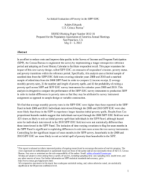An Initial Evaluation of Poverty in the SIPP-EHC
An Initial Evaluation of Poverty in the SIPP-EHC
Abstract
In an effort to reduce costs and improve data quality in the Survey of Income and Program Participation (SIPP), the Census Bureau re-engineered the survey by implementing a longer retrospective reference period and adopting an Event History Calendar to facilitate respondent recall. This paper examines the impact of this new survey design, called SIPP-EHC, on measures of respondent’s income, poverty status, and poverty transitions within the reference period. Specifically, this analysis uses a limited sample of unedited data from the SIPP-EHC field tests covering calendar years 2009 and 2010 and a matched sample of edited data from the 2008 SIPP Panel in order to compare 1) income receipt, 2) average monthly poverty rates, 3) the number and length of poverty spells, and 4) the probability of exiting a poverty spell across SIPP and SIPP-EHC survey instruments for calendar years 2009 and 2010. This analysis is designed to compare the performance of the SIPP-EHC survey instrument to production SIPP in order to isolate differences in poverty rates so that they may be attributed to survey instrument assignment as opposed to sample design or variable construction.
We find that average monthly poverty rates in the SIPP-EHC were higher than those reported in the SIPP Panel in both 2009 and 2010. Individuals interviewed through the 2009 and 2010 SIPP-EHC were also more likely than those in the SIPP to experience longer duration initial poverty spells. Results from Cox proportional hazards models suggest that individuals surveyed through the 2009 SIPP-EHC field test were .621 times as likely to exit an initial poverty spell than individuals in the SIPP Panel, although hazard rates for individuals interviewed in the 2010 SIPP-EHC field test were not statistically different than those interviewed in the SIPP Panel. The inclusion of time-varying covariates to flag for seam months in the SIPP Panel is significant in explaining differences in exit rates seen across the two survey instruments. Controlling for the significant impact of seam months in the SIPP survey, households in the 2009 and 2010 SIPP-EHC are more likely to exit an initial spell of poverty than households in the SIPP.
Others in Series
Working Paper
Working Paper
Working Paper




